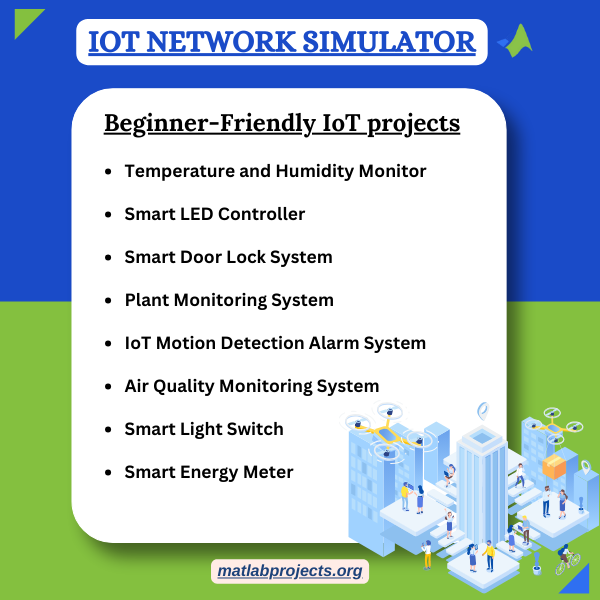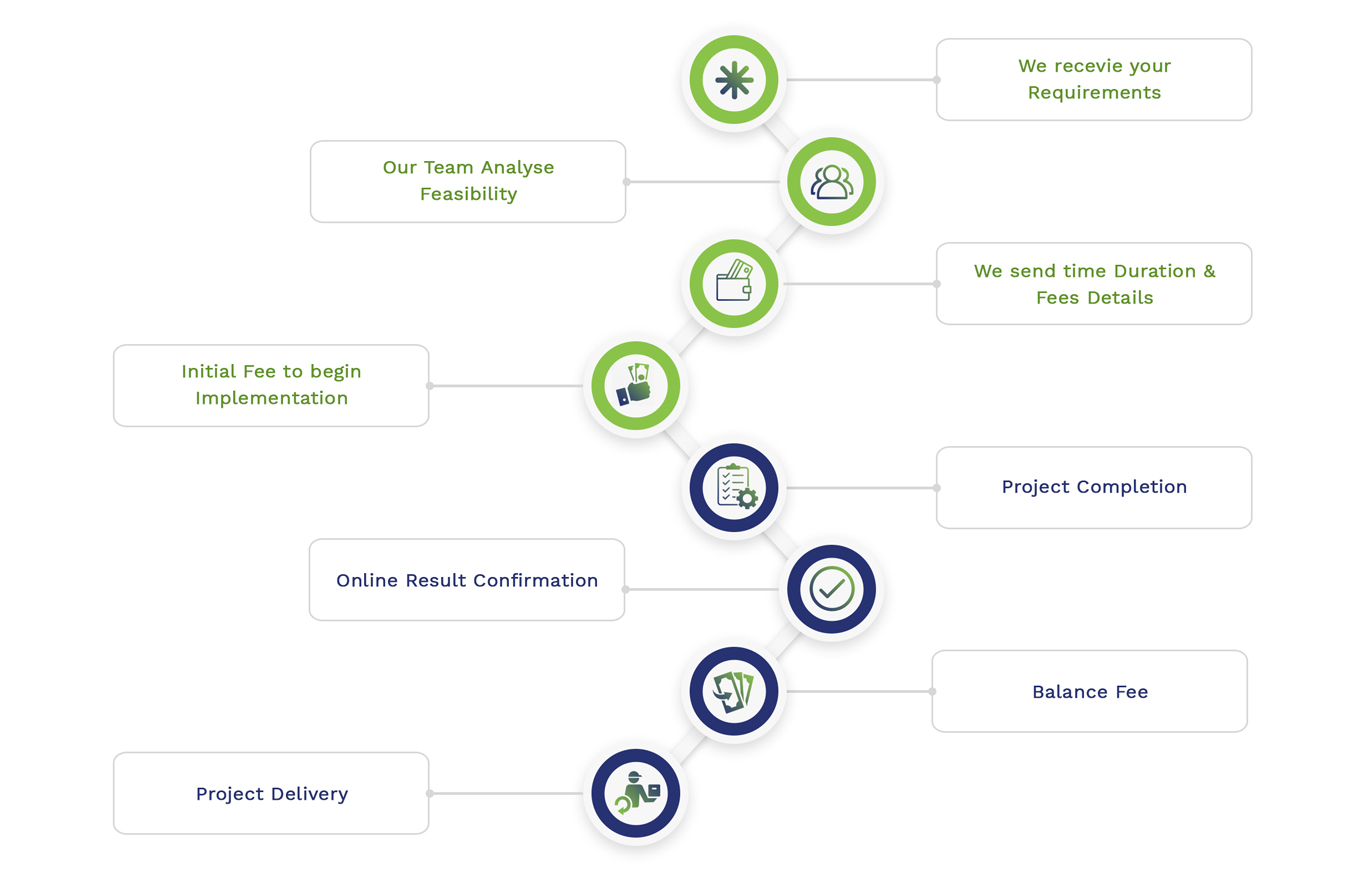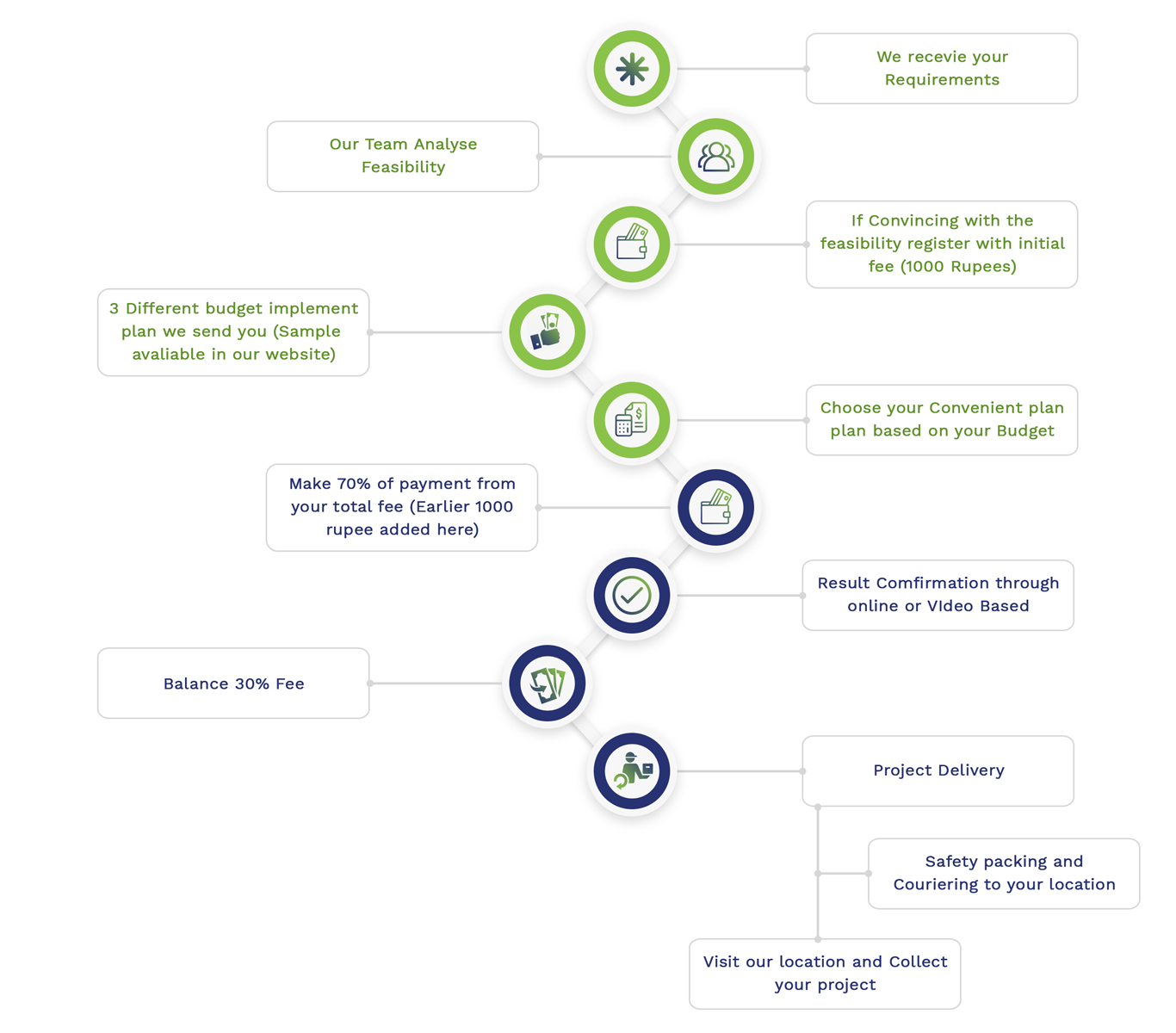In the IoT network, algorithms play an important role in the simulation process. We have also discovered some groundbreaking advancements in IoT Network Simulator research that will surely spark your curiosity. Once you join hands with matlabprojects.org, we hold your hand gently and guide you through every research obstacle, starting from IoT thesis ideas. By this article, we propose multiple extensive techniques with short description, applications and a model program in the network simulation process:
- Routing Algorithms
For effective data transmission in IoT networks, routing algorithms are very crucial.
- RPL (Routing Protocol for Low-Power and Lossy Networks):
- Explanation: Specifically, for LLNs (low-power and Lossy Networks), it is an advanced Distance-vector protocol.
- Application: It is highly applicable in OMNeT++, Ns-3 and Contiki (Cooja).
- Main Parameters: Trickle timer, OF (Objective Function) and DODAG construction are the involved key parameters.
// Example RPL Configuration in Contiki
#include “contiki.h”
#include “net/rpl/rpl.h”
Void configure_rpl () {
rpl_dag_t *dag;
Uip_ipaddr_t prefix;
Dag = rpl_set_root (&prefix);
rpl_set_prefix (dag, &prefix, 64);
}
- LEACH (Low-Energy Adaptive Clustering Hierarchy):
- Explanation: To reduce energy usage in wireless sensor networks, LEACH is a clustering-based protocol.
- Application: In NS-3 and OMNeT++, it is deployed broadly.
/ /Example LEACH Simulation in NS-3
Ptr<LeachClusterHead> head = CreateObject<LeachClusterHead>();
Head->SetEnergyThreshold (energyThreshold);
Head->SetAggregationLevel (aggregationLevel);
- Resource Management Algorithms
Particularly for fog and edge computing, effective resource management techniques are very essential.
Task Scheduling and Offloading Algorithms:
- Round-Robin Scheduling
- Explanation: These algorithms are basic equitable task scheduling techniques.
- Application: It is applicable in OMNeT++ and NS-3.
// Round-Robin Scheduling Example in NS-3
Ptr<RoundRobinScheduler> scheduler = CreateObject<RoundRobinScheduler>();
Scheduler->ScheduleTasks (tasks);
- Reinforcement Learning-Based Offloading:
- Explanation: This technique uses deep reinforcement learning and Q-learning for dynamic task offloading.
- Application: In iFogSim, OMNeT++ or NS-3, it demands custom deployment.
// Example Q-Learning Offloading in iFogSim (Pseudo Code)
QLearningAgent agent = new QLearningAgent ();
Double reward = agent.getReward (state, action);
agent.updateQValues (state, action, reward);
- Security Algorithms
Encompassing anomaly identification, accuracy and encryption techniques, it effectively protects IoT networks.
Lightweight Encryption Algorithms:
- PRESENT:
- Explanation: For resource-limited IoT devices, lightweight block cipher is highly adaptable.
- Application: Through custom modules, it is used in NS-3 and OMNeT++.
// PRESENT Cipher Example Implementation (Pseudo Code)
uint64_t present_encrypt (uint64_t plaintext, uint64_t key) {
Uint64_t ciphertext = apply_sbox (plaintext);
Ciphertext = apply_permutation (ciphertext);
Ciphertext ^= key;
Return ciphertext;
}
Intrusion Detection Algorithms:
- One-Class Support Vector Machine (OCSVM):
- Explanation: Considering the IoT network traffic, use OCSVM to identify outliers.
- Application: It crucially demands synthesization with machine learning models such as scikit-learn in Python.
# Example OCSVM Implementation in Python (Scikit-Learn)
From sklearn import svm
Clf = svm.OneClassSVM (nu=0.1, kernel=”rbf”, gamma=0.1)
clf.fit (training_data)
Anomalies = clf.predict (test_data)
- Network Traffic Modeling and Generation Algorithms
To evaluate the simulation outputs accurately, it is required to establish practical traffic patterns.
- Pareto Distribution-Based Traffic Generation:
- Explanation: On the basis of Pareto distribution, develop traffic patterns specifically for explosive traffics.
- Application: In OMNeT++ and NS-3, it can be deployed efficiently.
// Pareto Traffic Generation Example in NS-3
Ptr<ParetoOnOffApplication> paretoApp = CreateObject<ParetoOnOffApplication>();
ParetoApp->SetAttribute (“OnTime”, StringValue (“ns3::ParetoRandomVariable [mean=1.0]”));
ParetoApp->SetAttribute (“OffTime”, StringValue (“ns3::ParetoRandomVariable [mean=2.0]”));
- Markov Chain-Based Traffic Modeling:
- Explanation: For Markovian arrival processes, use Markov chains to develop traffic.
- Application: This Markov chain is widely applicable in NS-3 and OMNeT++.
// Markov Chain Traffic Modeling Example in NS-3
Ptr<MarkovOnOffApplication>
MarkovApp= CreateObject<MarkovOnOffApplication> ();
MarkovApp->SetAttribute (“MarkovModel”, PointerValue (MarkovModel));
- Data Aggregation Algorithms
In IoT networks, data aggregation decreases energy usage and network congestion.
- Cluster-Based Data Aggregation:
- Explanation: To reduce the network traffic, this aggregate data effectively uses cluster heads.
- Application: It is highly applicable in OMNeT++ and NS-3.
// Cluster-Based Data Aggregation Example in NS-3
Ptr<ClusterHead> clusterHead = CreateObject<ClusterHead>();
ClusterHead->AggregateData (dataPackets);
- Tree-Based Data Aggregation:
- Explanation: For the process of decreasing energy usage, this aggregate data deploys some specific tree patterns.
- Application: In Cooja, Ns-3 and OMNeT++, it might be applied.
// Tree-Based Data Aggregation Example in NS-3
Ptr<TreeAggregator> aggregator = CreateObject<TreeAggregator> ();
Aggregator->AggregateData (dataPackets);
- Network Protocols
By means of interpreting performance and adaptability, it is crucial to execute and simulate IoT protocols.
- MQTT (Message Queuing Telemetry Transport):
- Explanation: Especially for IoT devices, exhibit or subscribe protocol.
- Application: It is extensively used in MATLAB/Simulink, NS-3 and OMNeT++.
// MQTT Client Implementation Example (Pseudo Code)
MqttClient client = new MqttClient (brokerUri, clientId);
client.connect ();
Client. Subscribe (topic);
client.publish (topic, message);
- CoAP (Constrained Application Protocol):
- Explanation: As regards resource-limited devices, it acts as an advanced RESTful protocol.
- Application: OMNeT++, Contiki (Cooja) and NS-3 are the applicable areas.
// CoAP Server Implementation in Contiki (Cooja)
PROCESS_THREAD (coap_server_process, ev, data) {
PROCESS_BEGIN ();
coap_init_engine ();
rest_activate_resource (&resource temperature, “sensors/temperature”);
PROCESS_END ();
}
What are some good IOT projects to start with when you are new to this field and want to learn along with making beginner level project suggestions needed
If you are not familiar with the IoT field, select simple and practically attainable projects. Some of the fundamental and impactful research topics are recommended by us in the motive of guiding the inexperienced beginners:
- Temperature and Humidity Monitor
- Goal: Make use of DHT11/DHT22 sensor to observe temperature and rainfall and deliver data to the cloud.
- Aspects:
- Breadboard and jumper wires
- Arduino or ESP8266
- DHT11 or DHT22 sensor
- Measures:
- Initially, connect the sensor to the Arduino/ ESP8266.
- From the sensor, Read data by writing code.
- To an IoT setting such as Adafruit IO or Thing Speak, send data.
- Accessible Resources:
- ESP8266 ThingSpeak Tutorial
- DHT11 Arduino Tutorial
- Smart LED Controller
- Goal: Utilize your smartphone to manage an RGB LED or LED strip across Wi-Fi.
- Aspects:
- MOSFET transistors
- ESP8266 or ESP32
- Breadboard and jumper wires
- RGB LED or LED strip
- Measures:
- Through MOSFET transistors, connect the RGB LED to the ESP8266.
- By means of PWM signals, manage the KEDs by writing code.
- Across Wi-Fi, handle LED through developing a basic web interface.
- Accessible Resources:
- RGB LED with ESP8266
- Smart Door Lock System
- Goal: With the help of mobile apps or the web, construct a manageable and intelligent door lock system.
- Aspects:
- Magnetic reed switch or push button
- Breadboard and jumper wires
- Arduino or ESP8266
- Servo motor
- Measures:
- In order to act as a lock, connect the servo motor to the Arduino/ESP8266.
- Depending on web commands, write code to manage the servo motor.
- For the purpose of locking and unlocking, develop a basic mobile app or web interface.
- Accessible Resources:
- Using ESP8266 for Smart Lock.
- Plant Monitoring System
- Goal: If it is required, supervise the soil moisture levels and water the plant in an automated manner.
- Aspects:
- Water pump and relay module
- Soil moisture sensor
- Breadboard and jumper wires
- Arduino or ESP8266
- Measures:
- With the Arduino/ ESP8266, connect the soil moisture sensor.
- As a means to interpret moisture data and manage the water pump, write efficient code.
- For remote monitoring, send soil moisture data to IoT settings.
- Accessible Resources:
- Automatic plant Watering System
- IoT Motion Detection Alarm System
- Goal: Send a signal to your phone when motion is identified through this research, as it intends to model a motion detection alarm system.
- Aspects:
- Breadboard and jumper wires
- PIR motion sensor
- Arduino or ESP8266
- Buzzer or LED
- Measures:
- To the Arduino/ESP8266, connect the PIR motion sensor.
- When motion is recognized, activate an alarm by writing code.
- By means of an IoT platform, send a signal to your phone.
- Accessible Resources:
- Motion Recognition alarm with ESP8266
- Air Quality Monitoring System
- Goal: Acquire the benefit of a gas sensor to observe air quality and it delivers data to the cloud.
- Aspects:
- MQ135 gas sensor
- Breadboard and jumper wires
- Arduino or ESP8266
- Measures:
- The MQ135 sensor needs to be connected to the Arduino/ESP8266.
- To interpret air quality from the sensor, write code.
- For an IoT environment such as ThingSpeak, send air quality data.
- Accessible Resources:
- Air Quality Supervising System with ESP8266
- Smart Light Switch
- Goal: Use your smartphone to manage your lights by establishing a smart light switch.
- Aspects:
- Push button
- ESP8266 or ESP32
- Breadboard and jumper wires
- Relay module
- Measures:
- Initially, it is required to connect the relay module with ESP8266/ESP32.
- Through a web interface, write code to handle the relay module.
- To manage the relay artificially, insert a push button.
- Accessible Resources:
- ESP8266 Wi-Fi Light Switch
- Smart Energy Meter
- Goal: Regarding the actual-time, observe the consumption of electricity and send the data to the cloud.
- Aspects:
- Breadboard and jumper wires
- ACS712 current sensor or ZMPT101B voltage sensor
- Arduino or ESP8266
- Measures:
- With the Arduino/ESP8266, connect the up-to-date or voltage sensor.
- To estimate electricity consumption, write efficient code.
- Reflecting on IoT settings such as Blynk or ThingSpeak, send data.
- Accessible Resources:
- Smart Energy Meter with ESP8266
- Weather Station
- Goal: In order to supervise pressure, rainfall and temperature, construct a weather station.
- Aspects:
- BME280 or BMP180 sensor
- Arduino or ESP8266
- Breadboard and jumper wires
- Measures:
- Crucially, it needs to connect the BME280/BMP180 sensor with the Arduino/ESP8266.
- From the sensor, interpret weather data by writing code.
- Make use of Web dashboard for the process of sending data to an IoT platform.
- Accessible Resources:
- ESP8266 Weather Station
- Smart Parking System
- Goal: For the purpose of exhibiting the accessible parking place, develop a wise parking system.
- Aspects:
- Ultrasonic sensor
- Breadboard and jumper wires
- Arduino or ESP8266
- Measures:
- The ultrasonic sensor requires to be connected with Arduino/ESP8266.
- To identify the occurrence of a vehicle, write code.
- For an IoT environment, send the data of accessibility of parking places.
- Accessible Resources:
- Smart parking System with Arduino

IOT Network Simulator Topics & Ideas
Looking for guidance in the IoT Network Simulator domain? Look no further! We have shared a wide range of IoT Network Simulator thesis ideas, along with technology code and simulation support and research challenges, all provided by our top-notch technical experts. At matlabprojects.org, we constantly update our collection of the latest IoT network simulator topics and ideas, ensuring that we guide you in every aspect of IoT. Our ideas and topics have garnered significant attention in recent research, and scholars are eagerly awaiting more.
- Research on interaction of innovation spillovers in the AI, Fin-Tech, and IoT industries: considering structural changes accelerated by COVID-19
- Intelligent intrusion detection framework for multi-clouds – IoT environment using swarm-based deep learning classifier
- Distributed reinforcement learning-based memory allocation for edge-PLCs in industrial IoT
- Data transmission reduction formalization for cloud offloading-based IoT systems
- Performance evaluation of publish-subscribe systems in IoT using energy-efficient and context-aware secure messages
- Task partitioning and offloading in IoT cloud-edge collaborative computing framework: a survey
- Fog computing application of cyber-physical models of IoT devices with symbolic approximation algorithms
- Scaling-up production of cost-effective and eco-friendly bio-fertilizer and its application on Barley green fodder via IoT hydroponic system
- Enhancement of an IoT hybrid intrusion detection system based on fog-to-cloud computing
- ES-PPDA: an efficient and secure privacy-protected data aggregation scheme in the IoT with an edge-based XaaS architecture
- Flexible computation offloading in a fuzzy-based mobile edge orchestrator for IoT applications
- An experimental study of fog and cloud computing in CEP-based Real-Time IoT applications
- A blockchain-based SLA monitoring and compliance assessment for IoT ecosystems
- Improved Jellyfish Algorithm-based multi-aspect task scheduling model for IoT tasks over fog integrated cloud environment
- Multiple time series database on microservice architecture for IoT-based sleep monitoring system
- Engineering the advances of the artificial neural networks (ANNs) for the security requirements of Internet of Things: a systematic review
- Toward a smart health: big data analytics and IoT for real-time miscarriage prediction
- Big Data and precision agriculture: a novel spatio-temporal semantic IoT data management framework for improved interoperability
- A critical review of intrusion detection systems in the internet of things: techniques, deployment strategy, validation strategy, attacks, public datasets and challenges
- Machine learning-based cloud IOT platform for intelligent tourism information services
Subscribe Our Youtube Channel
You can Watch all Subjects Matlab & Simulink latest Innovative Project Results
Our services
We want to support Uncompromise Matlab service for all your Requirements Our Reseachers and Technical team keep update the technology for all subjects ,We assure We Meet out Your Needs.
Our Services
- Matlab Research Paper Help
- Matlab assignment help
- Matlab Project Help
- Matlab Homework Help
- Simulink assignment help
- Simulink Project Help
- Simulink Homework Help
- Matlab Research Paper Help
- NS3 Research Paper Help
- Omnet++ Research Paper Help
Our Benefits
- Customised Matlab Assignments
- Global Assignment Knowledge
- Best Assignment Writers
- Certified Matlab Trainers
- Experienced Matlab Developers
- Over 400k+ Satisfied Students
- Ontime support
- Best Price Guarantee
- Plagiarism Free Work
- Correct Citations
Expert Matlab services just 1-click

Delivery Materials
Unlimited support we offer you
For better understanding purpose we provide following Materials for all Kind of Research & Assignment & Homework service.
 Programs
Programs Designs
Designs Simulations
Simulations Results
Results Graphs
Graphs Result snapshot
Result snapshot Video Tutorial
Video Tutorial Instructions Profile
Instructions Profile  Sofware Install Guide
Sofware Install Guide Execution Guidance
Execution Guidance  Explanations
Explanations Implement Plan
Implement Plan
Matlab Projects
Matlab projects innovators has laid our steps in all dimension related to math works.Our concern support matlab projects for more than 10 years.Many Research scholars are benefited by our matlab projects service.We are trusted institution who supplies matlab projects for many universities and colleges.
Reasons to choose Matlab Projects .org???
Our Service are widely utilized by Research centers.More than 5000+ Projects & Thesis has been provided by us to Students & Research Scholars. All current mathworks software versions are being updated by us.
Our concern has provided the required solution for all the above mention technical problems required by clients with best Customer Support.
- Novel Idea
- Ontime Delivery
- Best Prices
- Unique Work
Simulation Projects Workflow

Embedded Projects Workflow



 Matlab
Matlab Simulink
Simulink NS3
NS3 OMNET++
OMNET++ COOJA
COOJA CONTIKI OS
CONTIKI OS NS2
NS2






